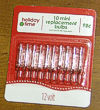 | |||

|
 |  | |
 |  | ||
 |
 | ||
 |  | ||
 |  | ||
 | |||

|
 |  | |
 |  | ||
 |
 | ||
 |  | ||
 |  | ||


| Almost-Free Building Lighting This project uses inexpensive and salvaged supplies to create 12-volt lighting options for your buildings. The only part you have to buy is a package of 12-volt replacement bulbs for Christmas lighting strands. I got mine at WalMart near the shelves with the Christmas lights. They are also available online This project uses inexpensive and salvaged supplies to create 12-volt lighting options for your buildings. The only part you have to buy is a package of 12-volt replacement bulbs for Christmas lighting strands. I got mine at WalMart near the shelves with the Christmas lights. They are also available online
I started using 12-volt garden lighting to light my garden railroad buildings some years back, but many folks had trouble finding the "wedge" sockets they needed to follow my example. This solution is better in several ways:
By the way, if you're using this for indoor buildings (with a recycled 12volt power supply), this solution will tend to be cheaper and require less power than either the 18-volt solutions sold to model railroaders or the 110-volt night-light-style bulbs sold to ceramic village owners. What You Need
About the Shapes of the Bases and BulbsYou'll notice that the base shape of the lights varies among brands, or even year-to-year in the same brand. But the shapes of the lamps are usually more-or-less the same, as you can see in the pictures below. Yes, for this project I cut up a defective Halloween light strand, but the principle is the same as long as it's an indcandescent strand.
How to Do It
Notes on Series Versus Parallel WiringThough you started with a light strand designed for series wiring, the lighting system you will be creating in this project will need parallel wiring to work with your 12-volt power supplies. In case they forgot to teach this in your elementary school science class, here's a quick breakdown of the differences.
The most important disadvantage of series wiring is that if one bulb is removed, all the lights go off. Another disadvantage for model railroading or similar uses is that you can't add or remove lighting without having an effect on the rest of the lights in the system. If you add an extra light by splicing it into a series system, it adds more resistance and every bulb in the system gets less electricity than it did before. Conversely, if you remove a light and splice the gap back together(maybe because you're moving a bulding), there is now less resistance in the circuit, and every bulb gets a bit more electricity - potentially more than it was designed to handle.
Advantages of parallel lighting circuits include:
Disadvantages might include the fact that you need a low-voltage power supply, since you can't rely on a bunch of lights in a series to bring 110/120 volt current down to a safe level for your bulbs. Of course, if you have lighting in your garden, you probably already have a 12-volt power supply anyway. And if you don't, they're easy to come by. What About The Accessory Line on My Model Train's Power Supply?Most model railroad power supplies have terminals you can use to power things like street lamps. Unfortunately, you can't use this kind of system with those, since the power supplies typically give off 18 volts, and the highest voltage bulbs you can get for this kind of Christmas lighting are 12 volts. You could wire two nine-volt bulbs in a series, which would enable the pair of them to survive an 18-volt system, but that gets complicated in a hurry.How Do I Mount the Bulbs?Since you're dealing with a low-voltage bulb that isn't going to get very hot, the main thing is to keep it from laying right against something flammable. One method, if your building is wood, would be to staplegun the wires to a wall or ceiling in such away that the socket holds the bulb out away from the wood. For temporary applications, I suppose you could use duct tape the same way, but I wouldn't trust that to hold up long-term, especially outside.Other UsesOnce you have figured out how to get a boatload of 12-volt lighting circuits for only a few dollars, you will come up with other applications. For example, my friend Wil Davis adds external lighting to his buildings using bulbs similar to these (though smaller), Personally I like the approach of each building having internal and external lights if possible. The lights are wired in parallel, with the wires spliced together to a single line that you can route back to the power source (or a 12-volt garden lighting circuit). Long before I wrote this article, I did this by using buildings with attached sidewalks that I could add lampposts to, as well as fastening a socket inside the building. One friend makes plexiglass bases for his buildings that include "sidewalks" he can fasten his lampposts. By lighting a building at a time, you create a system that allows you to hook up or unhook a building by connecting a single pair of wires. The extra lighting will make your railroad or Christmas village look that much more magical, and you will stay saner during installation and brea kdown. ConclusionIn past years, one big holdup to properly lighting buildings was the cost of the little bulbs and sockets made for the purpose - a $3 setup to add one 12 volt light is typical. When I found a source for wedge sockets so I could use garden lighting bulbs, that was better, but not everybody has access to those builbs. The solution in this article uses mostly scrap materials and cheap supplies that, with a little imagination, can be as flexible as you would like. If you try out something similar and have any feedback at all, please get in touch and let us know what works and what doesn't work for you. Above all, enjoy your trains, and any time you have with your family in the coming months.
*Strands over 50 lights often have two sets of series wiring - that's why half of the strand can go out while the other half is still going.
*Strands over 50 lights often have two sets of series wiring. So a strand of 60 might have two discrete circuits that handle 30 bulbs each. That's why replacement lamps for a 60-bulb strand might be the same as the replacement lamps for a 30-bulb strand - the strand is electrically equivalent to two 30-lamp strands.
|


 TM Buyer's Guide Pages"> TM Buyer's Guide Pages">

|

| 
|
 |
 |
 |
 |
 |
Note: Family Garden TrainsTM, Garden Train StoreTM, Big Christmas TrainsTM, BIG Indoor TrainsTM, and BIG Train StoreTM are trademarks of Breakthrough Communications (www.btcomm.com). All information, data, text, and illustrations on this web site are Copyright (c) 1999, 2000, 2001, 2002, 2003, 2004, 2005, 2006, 2007, 2008, 2009, 2010, 2011, 2012, 2013 by Paul D. Race. Reuse or republication without prior written permission is specifically
forbidden.
Family Garden Trains is a participant in the Amazon Services LLC Associates Program, an affiliate advertising program designed to provide a means for sites to earn advertising fees by advertising and linking to amazon.com.
For more information, please contact us

 |  |